|
|
Sen to Chihiro no Kamikakushi |
|
|
E ni inochi o fukikome
(Breathing life into drawings) A Ningen Document ("Human Documentary") about the makers of Studio Ghibli's upcoming new film Broadcast in Japan by NHK on May 4, 2000; Length: approximately 40 minutes |
Editors' Note: We hope that this extended summary will be informative and interesting to the many fans of the works of Studio Ghibli who did not have the opportunity to see the original broadcast of the TV program in Japan.
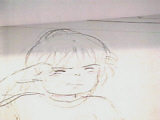
|
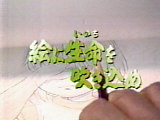
|

|
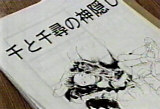
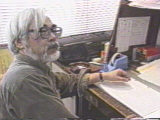
Intro: We see Film Director Hayao MIYAZAKI working on pencil tests of the main character Chihiro, from Sen to Chihiro no Kamikakushi, an animation feature film (planned for 1 hour and 50 minutes length) scheduled to be released in Summer 2001. The narrator explains Miyazaki's insistence that his animators abandon their usual drawing habits, and pay careful attention to the details of facial and body movement of the characters, thus "breathing life" into their drawings. Therefore, Miyazaki requires his animators to always think hard about what one wants to draw in one's picture, and how one can improve one's drawing. This program follows three Ghibli key animators in their quest to achieve this goal in the new film.
An outside view of the main building of Studio Ghibli in the Koganei suburb of Tokyo, where Mononoke Hime -- the highest-grossing Japanese film to date -- was completed three years before. Since Ghibli's animators typically work 10-hour days or longer, Miyazaki wished them to have a bright and pleasant work environment, and designed the studio building in the early 1990s.
 The camera tracks a young animator fetching coffee from the canteen on
the first floor of the main studio building, and ascending the
staircase to the second floor, where the animators work [see
Note 1]. This is
Atsushi TAMURA, who has worked at Ghibli for five
years, but is serving as a key animator for the first time on the new
film; he worked in the inbetween/cleanup animation department for
Mononoke Hime.
The camera tracks a young animator fetching coffee from the canteen on
the first floor of the main studio building, and ascending the
staircase to the second floor, where the animators work [see
Note 1]. This is
Atsushi TAMURA, who has worked at Ghibli for five
years, but is serving as a key animator for the first time on the new
film; he worked in the inbetween/cleanup animation department for
Mononoke Hime.
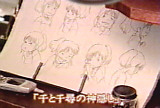 Character Sketches |
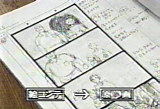 E-konte |
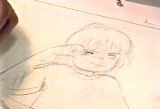 Genga |
The competition for animation jobs at Ghibli is high -- 40 or 50 applicants for each position. Ghibli has selected 16 key animators for the new film. First, Miyazaki draws the E-konte ("continuity pictures") book for the film, which corresponds to the script for a movie [see Note 2]. Then, the 16 key animators draw many sequential original pictures -- called Genga (key animation drawings) -- to create a reference framework of the characters' facial expressions and body movements.
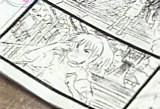
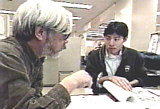 We see Miyazaki critiquing one of Tamura's pencil
tests. Miyazaki complains that the movement of
Chihiro's neck isn't quite right. Tamura pores over
his copy of the E-konte book with Miyazaki.
Tamura's current assignment is a five-second scene (Cut
131) in which Chihiro first wakes up in the majo no
sekai ("witch's world"); Chihiro rubs her eyes, wondering
where she is. Miyazaki urges Tamura to vary
Chihiro's facial expression and body movement to express her
fuan ("anxiety") throughout the scene. Besides
the E-konte book, we also see a layout drawing done by
Miyazaki for this scene.
We see Miyazaki critiquing one of Tamura's pencil
tests. Miyazaki complains that the movement of
Chihiro's neck isn't quite right. Tamura pores over
his copy of the E-konte book with Miyazaki.
Tamura's current assignment is a five-second scene (Cut
131) in which Chihiro first wakes up in the majo no
sekai ("witch's world"); Chihiro rubs her eyes, wondering
where she is. Miyazaki urges Tamura to vary
Chihiro's facial expression and body movement to express her
fuan ("anxiety") throughout the scene. Besides
the E-konte book, we also see a layout drawing done by
Miyazaki for this scene.
Tamura tells us that he passed Ghibli's "entrance exam" for animators while still in high school. However, he chose to attend college before coming to work at Ghibli, and proudly displays a framed letter from Miyazaki congratulating him on his decision and exhorting him to get "experience of the world" as well as learning how to draw. Miyazaki especially emphasizes in his note to Tamura that one should improve four basic abilities or skills in order to became a succesful animator: observation, sensibility, curiosity, and general knowledge. After graduating from the college, Tamura retook Ghibli's entrance exam (and obviously passed it again).
During his session with Tamura, Miyazaki tells him, "A key animator must make his best judgement about which movements must be emphasized or be omitted from his Genga based solely upon his sensibility and drawing skills as an animator. Therefore, everyone has to learn these skills and sensibilities from one's experience. The bottom line is that you must observe other people, recall your memories, and analyze sequences of the movement of 'look around with fear.'"
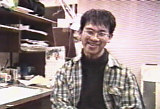
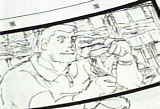 Next we meet Hiromasa YONEBAYASHI, at 26 the youngest
key animator at Ghibli. He's worked at Ghibli for four years,
after dropping out of university (where he had studied commercial
drawing and advertising). Like Tamura, he worked in the
inbetween/cleanup animation department for Mononoke
Hime. Yonebayashi's current assignment is a seven-second
scene (Cut 97) in which Chihiro's father (still in human form)
hungrily stuffs his mouth ("mouzen to kuu") with an egg roll,
and simultaneously picks up a piece of rare beef steak from the
dish. Stuffing one's face is a common motif in Miyazaki's work;
the narrator likens this scene to similar ones in
Cagliostro no Shiro,
Meitantei Holmes, and
Tenkuu no Shiro Laputa.
Yonebayashi furtively uses a digital video camera (on which
he spent a month's salary) to capture shots of his colleagues
eating, because he has realized that it is very difficult to
understand and analyze the action of eating -- such an
everyday, unconscious movement.
Next we meet Hiromasa YONEBAYASHI, at 26 the youngest
key animator at Ghibli. He's worked at Ghibli for four years,
after dropping out of university (where he had studied commercial
drawing and advertising). Like Tamura, he worked in the
inbetween/cleanup animation department for Mononoke
Hime. Yonebayashi's current assignment is a seven-second
scene (Cut 97) in which Chihiro's father (still in human form)
hungrily stuffs his mouth ("mouzen to kuu") with an egg roll,
and simultaneously picks up a piece of rare beef steak from the
dish. Stuffing one's face is a common motif in Miyazaki's work;
the narrator likens this scene to similar ones in
Cagliostro no Shiro,
Meitantei Holmes, and
Tenkuu no Shiro Laputa.
Yonebayashi furtively uses a digital video camera (on which
he spent a month's salary) to capture shots of his colleagues
eating, because he has realized that it is very difficult to
understand and analyze the action of eating -- such an
everyday, unconscious movement.
Miyazaki examines Yonebayashi's initial pencil tests, complaining that the father isn't tearing into the food hungrily enough. Miyazaki insists also that when the father pulls the egg roll away from his mouth after taking a bite, we should see the details of the movement of the half-bitten egg roll in his hand -- which should express the hardness of the cooked egg roll -- and the contents of the egg roll as they hang out from the place where it has been bitten off.
The action of eating consists of many different movements, and each movement expresses a specific situation of an eater. Each eater has a different rhythm of biting, and a different method of moving the food inside of his mouth. Therefore, there are many options for an animator to choose each movement and facial and body expression in drawing his Genga. Miyazaki says to the camera, "[Yonebayashi-san] has not yet understood what he cannot draw. He has not recalled and observed enough to express 'mouzen to kuu' in his drawing. I am sure that he must have his own idea of 'hungry' and 'eating' based upon his life experience." Yonebayashi has a week to draw the seven seconds of this scene.
 Tamura has finished his Genga after only two days, and
enters his drawings of Chihiro into the computer. In his
drawings, he has emphasized Chihiro's eye movements of looking around
to express her anxiety. At the same time, he wonders if the
length of time during which she rubs her eyes might be too short for
the scene. Then Miyazaki and the Animation Director
[Masashi ANDOU]
check Tamura's work. Miyazaki thinks
that Chihiro's hand and mouth movements are wrong, and that her head
must tilt more. Miyazaki uses Tamura's Genga to
"widen" the image, and thinks there should be more movement.
They discuss the process of rubbing one's eyes. Tamura must
change many aspects of his Genga -- angles of neck and arm,
wrinkles in clothes, etc. Eventually, Tamura gives up
correcting the 18 sheets of his first Genga, and will redraw
the scene from scratch.
Tamura has finished his Genga after only two days, and
enters his drawings of Chihiro into the computer. In his
drawings, he has emphasized Chihiro's eye movements of looking around
to express her anxiety. At the same time, he wonders if the
length of time during which she rubs her eyes might be too short for
the scene. Then Miyazaki and the Animation Director
[Masashi ANDOU]
check Tamura's work. Miyazaki thinks
that Chihiro's hand and mouth movements are wrong, and that her head
must tilt more. Miyazaki uses Tamura's Genga to
"widen" the image, and thinks there should be more movement.
They discuss the process of rubbing one's eyes. Tamura must
change many aspects of his Genga -- angles of neck and arm,
wrinkles in clothes, etc. Eventually, Tamura gives up
correcting the 18 sheets of his first Genga, and will redraw
the scene from scratch.
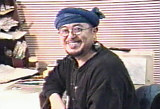 Following his meeting with Miyazaki, Tamura says he is appreciative of
Miyazaki's advice. He goes to Yonebayashi's desk and tells
Yonebayashi about his meeting with Miyazaki. Tamura's and
Yonebayashi's sempai or senior colleague [the animator with
the blue towel on his head at the next desk] says that the job of
animator is not suitable for "ordinary people," because it is usual to
have to redo things many times. All sempai animators at
Ghibli have experienced the same very demanding "rite of passage" to
become successful Ghibli animators as Tamura and Yonebayashi are
facing now.
Following his meeting with Miyazaki, Tamura says he is appreciative of
Miyazaki's advice. He goes to Yonebayashi's desk and tells
Yonebayashi about his meeting with Miyazaki. Tamura's and
Yonebayashi's sempai or senior colleague [the animator with
the blue towel on his head at the next desk] says that the job of
animator is not suitable for "ordinary people," because it is usual to
have to redo things many times. All sempai animators at
Ghibli have experienced the same very demanding "rite of passage" to
become successful Ghibli animators as Tamura and Yonebayashi are
facing now.
Meanwhile, a week has passed already. Yonebayashi has made many drawings, but still can't draw the action of "mouzen to kuu" because he doesn't have that experience. In fact, he was usually the last one to finish his lunch at his elementary school, and in his entire life has never felt a strong urge to eat.
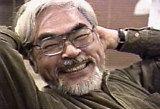 Miyazaki takes a look at Yonebayashi's latest batch of drawings.
Afterwards, Miyazaki comments to the camera that if he insists that
Yonebayashi draw quickly, the results would be bad -- Yonebayashi would
"tense up" and not be able to put emotion into his drawings.
Therefore, Miyazaki will give Yonebayashi some more time.
Miyazaki comments that in the wild, when animals see their young
offspring "tense up", they will push them into action, or even kill
them, because they are too weak to survive. Miyazaki says
laughingly that he often has this feeling when he sees new animators
afraid to try new things, or to express themselves. But he also
thinks that animators under such pressure often don't produce their
best work. He knows, however, that intensity under high pressure
is one of the most important factors for producing the best
performance from [some] artists.
Miyazaki takes a look at Yonebayashi's latest batch of drawings.
Afterwards, Miyazaki comments to the camera that if he insists that
Yonebayashi draw quickly, the results would be bad -- Yonebayashi would
"tense up" and not be able to put emotion into his drawings.
Therefore, Miyazaki will give Yonebayashi some more time.
Miyazaki comments that in the wild, when animals see their young
offspring "tense up", they will push them into action, or even kill
them, because they are too weak to survive. Miyazaki says
laughingly that he often has this feeling when he sees new animators
afraid to try new things, or to express themselves. But he also
thinks that animators under such pressure often don't produce their
best work. He knows, however, that intensity under high pressure
is one of the most important factors for producing the best
performance from [some] artists.
Yonebayashi returns by bicycle from a convenience store with a bag full of food, including gyouza (Chinese dumpling or jiao-ji), chikuwa (a kind of fish paste cooked in a bamboo-like shape), and various Chinese foods. He knows he has to finish drawing his scene quickly, but he wants to start over by observing people's actions in eating. Two colleagues help Yonebayashi out by "chowing down" in front of his video camera in the Ghibli conference room. The first guy eats too smoothly to be of help, but the second eats in a fashion close to what Miyazaki has specified for this scene. By studying his video, Yonebayashi realizes that the motions not only of the mouth and teeth themselves, but also of the lips and muscles around the chin, really express the action of eating. Yonebayashi now feels he is ready to redraw the scene.
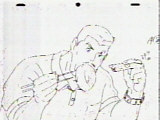 However, although Yonebayashi is recognized as one of
Ghibli's most skilled animators, even now he can't draw the
action of "mouzen to kuu." As Yonebayashi
puts his latest Genga into the computer, the narrator
comments that Yonebayashi's struggle is to put life into
his animation. Yonebayashi has been going constantly
between his work desk and the computer station, and is at the
point that he can't draw anymore. Despite all his
struggles, he doesn't know how to breathe life into the
scene. He says to the camera, "I know something
is wrong, but I don't know what is wrong in my
drawings."
However, although Yonebayashi is recognized as one of
Ghibli's most skilled animators, even now he can't draw the
action of "mouzen to kuu." As Yonebayashi
puts his latest Genga into the computer, the narrator
comments that Yonebayashi's struggle is to put life into
his animation. Yonebayashi has been going constantly
between his work desk and the computer station, and is at the
point that he can't draw anymore. Despite all his
struggles, he doesn't know how to breathe life into the
scene. He says to the camera, "I know something
is wrong, but I don't know what is wrong in my
drawings."
Miyazaki says to the camera, "Yonebayashi-san has not yet understood and analyzed enough to create his own eating movements. He has thought about it very hard, but... I think that this experience has revealed the weak point of his personality and his attitude toward his own life. He has realized that he must overcome the obstacle in front of him. Therefore, his struggle to understand and overcome the obstacle, will make him realize how he should live his life. He may not improve his drawing for the scene in such a short time. If so, that is ok; the important thing is that he will learn something important about the real world."

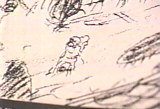 The third key animator whom we meet is
Mariko MATSUO. She has worked at Studio
Ghibli for eight years, and currently is working for the third time as
a key animator on a Ghibli film. She is seen working on a
four-and-a-half-second scene (Cut 144) in which Chihiro runs through a
small street to a big street while she is looking for her lost
parents. Miyazaki's description of this scene in the E-
konte book is, "Chihiro panic ni ochiru" ("Chihiro falls
into a panic"). Matsuo was also a key animator for
Mononoke Hime.
The third key animator whom we meet is
Mariko MATSUO. She has worked at Studio
Ghibli for eight years, and currently is working for the third time as
a key animator on a Ghibli film. She is seen working on a
four-and-a-half-second scene (Cut 144) in which Chihiro runs through a
small street to a big street while she is looking for her lost
parents. Miyazaki's description of this scene in the E-
konte book is, "Chihiro panic ni ochiru" ("Chihiro falls
into a panic"). Matsuo was also a key animator for
Mononoke Hime.
Matsuo tells the camera, "The 1978 TV animation series directed by Miyazaki-san, Mirai Shounen Konan, was my inspiration to become an animator. When I saw Mirai Shounen Konan for the first time, I felt very good about how Conan [the main character] and his friend [Jimsy] run around on the wing of the airplane named Gigant. I did not understand what made me so happy, and feel good about their running. But it was an excellent run! I know how I feel in my body when I run so smoothly and lively, even though I may not be able to express my feeling in words. I wanted to draw something like that."
Given her current assignment, she is sure that she can draw Chihiro's panicky search for her lost parents by recalling her own childhood experience of being lost. Apparently, Matsuo had become lost in a big supermarket, and had run through narrow passages between tall shelves. In the scene, Chihiro will scream "Otou-san" and "Okaa-san" ("Father" and "Mother") after she runs through a narrow street to a wide street surrounded by big buildings and Obakes (witches). Matsuo knows how to breathe life into the scene.
 In Matsuo's scene, Chihiro's body size is too small to add any facial
expression. Therefore, she added her own original leg movements
for Chihiro into the scene to express her panic. Chihiro moves
around many times while she screams "O-to-u-sa-n" and
"O-ka-a-sa-n." [Note that the Japanese hiragana
characters for these words are written individually on the sheets of
Matsuo's Genga of Chihiro's shout, corresponding to the
mouth movements for each syllable.] After seeing Matsuo's
original ideas for express Chihiro's panic, Miyazaki is very happy
with her ideas and tries to expand Chihiro's leg movements.
Matsuo says to the camera, "Whenever I get a new scene, I think about
how I myself would move in the given situation. Then I reflect
my thoughts in my drawings." This is the way in which Miyazaki
always asks his animators to work.
In Matsuo's scene, Chihiro's body size is too small to add any facial
expression. Therefore, she added her own original leg movements
for Chihiro into the scene to express her panic. Chihiro moves
around many times while she screams "O-to-u-sa-n" and
"O-ka-a-sa-n." [Note that the Japanese hiragana
characters for these words are written individually on the sheets of
Matsuo's Genga of Chihiro's shout, corresponding to the
mouth movements for each syllable.] After seeing Matsuo's
original ideas for express Chihiro's panic, Miyazaki is very happy
with her ideas and tries to expand Chihiro's leg movements.
Matsuo says to the camera, "Whenever I get a new scene, I think about
how I myself would move in the given situation. Then I reflect
my thoughts in my drawings." This is the way in which Miyazaki
always asks his animators to work.
Meanwhile, Tamura has completed 27 new sheets of Genga in three days. In his new drawings, in order to express Chihiro's anxiety, he has enlarged Chihiro's movements of her hand rubbing her eyes; he also emphasized the distortion of her lips and mouth. In addition to these, he has added a new body movement in which Chihiro leans forward in order to look around carefully. After checking Tamura's new Genga, Miyazaki is satisfied with his work overall. However, Miyazaki argues with Tamura about why Chihiro moves her body backwards after leaning forward. Miyazaki wants Tamura to think about Chihiro's personality, and express her attitude towards life, in his drawings. Miyazaki's point is that Chihiro is a positive person with a very strong will; therefore, once she leans her body forward, she will/should never move it back. Miyazaki says to Tamura, "Intensive observation is imperative for animators to improve and establish their own drawing skills in order to make their audience feel and realize the characters' lives, and the reality of the story."
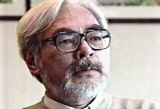 Miyazaki says to the camera, "Animators must work and think very
hard in order to reach the limits of their capabilities. I know
that all my animators have been working under intense pressure, but I
believe that is one of reasons why they have drawn their best in all
Ghibli's films. You know what? When we finish our drawings with
the best results, we will see the best satisfaction as
animators. That is the real enjoyment of the animator's
life." While the camera shows us Yonebayashi's intense
facial expression as he works, we hear Miyazaki say, "You just
have to live up to your own 'mouzen to kuu.'"
Miyazaki says to the camera, "Animators must work and think very
hard in order to reach the limits of their capabilities. I know
that all my animators have been working under intense pressure, but I
believe that is one of reasons why they have drawn their best in all
Ghibli's films. You know what? When we finish our drawings with
the best results, we will see the best satisfaction as
animators. That is the real enjoyment of the animator's
life." While the camera shows us Yonebayashi's intense
facial expression as he works, we hear Miyazaki say, "You just
have to live up to your own 'mouzen to kuu.'"
Yonebayashi has finally completed 52 sheets of his Genga (for the seven-second scene) after 16 days. The Animation Director and Miyazaki check and complete the final Genga. Miyazaki still challenges some of the movements in Yonebayashi's Genga, but with satisfaction in his big smile. "In Yonebayashi-san's drawings, the father opens his mouth too widely, and eats too quickly. If he wants to give more realistic feeling to the audience, he should make the father eat more slowly."
 We see Miyazaki and his key animators (including Tamura,
Yonebayashi, and Matsuo) discussing their next
assignments. As a daily routine, Miyazaki goes to Tamura's
desk and advises him, "You should dump your old drawings.
Put more new paper in the nearest shelf to your hand, so that you can
easily start new drawings." The narrator tells us, "The Ghibli
animators always draw all their own life experiences into their
scenes, even scenes of only a few seconds. That is how they
breathe life into drawings. In this spirit, they will draw
80,000 sheets of Genga for the new film during this
year."
We see Miyazaki and his key animators (including Tamura,
Yonebayashi, and Matsuo) discussing their next
assignments. As a daily routine, Miyazaki goes to Tamura's
desk and advises him, "You should dump your old drawings.
Put more new paper in the nearest shelf to your hand, so that you can
easily start new drawings." The narrator tells us, "The Ghibli
animators always draw all their own life experiences into their
scenes, even scenes of only a few seconds. That is how they
breathe life into drawings. In this spirit, they will draw
80,000 sheets of Genga for the new film during this
year."
Note 1: Background artists work on the third floor of the Studio Ghibli building; the canteen, meeting rooms, and administrative offices are on the first floor; and the multiplane camera and other recording equipment are in the basement. There is also a rooftop garden designed by one of Miyazaki's sons. [Take a virtual tour of Studio Ghibli.]
Note 2: Each page of the E-konte book has four columns: the cut number; a rough drawing of the characters and background involved in the cut; a text description of the cut; and the dialogue and/or sound effects (if any) for the cut.
Summary by Mikiyo HATTORI and Tom WILKES; HTML design and video captures by Marc GREGORY
Disclaimer:
©2000 NHK, Nibariki, Studio Ghibli, and/or other
appropriate copyright holders.
Translated and summarized without permission for
personal entertainment purposes only. The
quotations contained in this summary are not,
by any means, accurate word for word translations, and the
translators are solely responsible for any mistranslation or
misunderstanding.